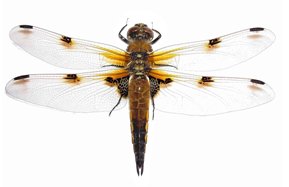 |
| Libellula
quadrimaculata |
 |
|
Common Name:
|
Four-spotted Chaser, Four-spotted
Skimmer |
|
Odonata |
|
Order:
|
Odonata |
|
Suborder:
|
Anisoptera |
|
Family:
|
Libellulidae |
|
Genus:
|
Libellula |
|
Species:
|
L. quadrimaculata |
|
|
| The
Name |
| Libellula quadrimaculata (Linnaeus,
1758), the Four-spotted Chaser, known in North America as the Four-spotted
Skimmer, is a dragonfly of the family Libellulidae found frequently throughout
Europe, Asia, and North America. The four wing spots give this species
its name; the wings also have a large brown patch at base. Both sexes are
similar with brown bodies tapering to a black tip. There is a variant form,
praenubila Newman, which has exaggerated wing spots. This is believed to
be related to water temperatures during larval development, and appears
to be more common in Europe than in the Americas.
This species may be confused with
females and immature males of the Broad-bodied Chaser Libellula depressa
and the Black-tailed Skimmer Orthetrum cancellatum, however in the latter
two species there is no dark spot on the middle of the leading edge of
the wings.
|
| The
Characteristics |
| The four-spotted chaser (Libellula
quadrimaculata) is a medium size dragonfly with length around 39-48mm.
It gets its name form the four dark spots present at the midpoint of the
front of each of its four wings. Unusually for this family, males and females
are much alike in appearance; the basic colouration is dark honey-brown,
with a paler scalloped edge to both sides of the abdomen. The tip of the
abdomen is black.
This rather uniformly brown dragonfly
is quite active in late spring and summer. The sexes are alike with a brown
abdomen becoming darker towards the rear, a brown thorax and brown eyes.
The is a row of yellow spots along each side of the abdomen. The most noticeable
feature is the colouring of the wings. The nodus (half-way along the leading
edge of each wing) has a very dark spot, which gives the insect its name.
The wing bases are also very dark and a colour form praenubila has a general
darkening of the wing tips.
The male is considered to be highly
aggressive and will defend a given territory from incursions from other
males of the species. The male is known to form preferences for prominent
perches and will often return to the same perches around the margins of
pools and ponds whilst it patrols for intruders. Both sexes are prolific
fliers and mating takes place in the air, rather than on perches or amongst
the vegetation. The female lays her eggs on floating vegetation. They tend
to be easier to approach than Broad-bodied Chasers.
This active Dragonfly mainly lives
by ponds, vernal pools, and slow flowing rivers; their flight period is
April to early September, but is most common in June and July.
|
| The
Reproduction and Development |
| Sexually active males are highly
territorial and select a prominent perch over-looking the water to look
for females, other males and prey, defending the airspace around waterside
perch from which they feed, chasing rival males or attempt to mate with
passing females. Mating is brief in mid-air. Females perch away from water
to avoid harrassment by the males, only venturing to the water when they
are ready to deposit eggs. This is a wandering species and may migrate
long distances.
females oviposit alone with male
in attendance, releasing eggs by dipping abdomen on water surface over
patches of aquatic plants. Eggs hatch after c1 month. Larvae live amongst
plant debris and take 2 years to develop. Emergence occurs in early morning
on emergent and marginal vegetation.
It prefers small oligotrophic and
mesotrophic pools and lakes, often with little open water, but also large
lakes and brackish sites. Adults feed predominantly on mosquitoes, gnats
and midges; the larvae feed primarily on other aquatic insect larvae and
on tadpoles.
|
| The
Distribution |
| Common and widespread.
|
| The
Protection Status |
| Libellula quadrimaculata is very
widespread and common over much of its range, with no threats across its
range and is assessed in IUCN Red List as Least Concern. |
|
References:
http://en.wikipedia.org/wiki/Four-spotted_Chaser
http://www.british-dragonflies.org.uk/species/four-spotted-chaser
http://www.habitas.org.uk/dragonflyireland/5639.htm
|
| The
Species on Stamps |
|
|
|
|
|
|
Home | Country
List | Species List
|
|